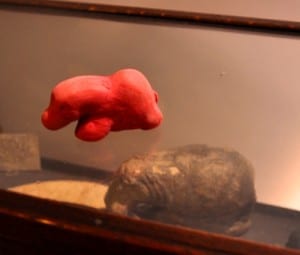This year saw another lively and successful Bloomsbury festival with collections, performances, and art installations being opened up for anyone to visit and enjoy. In the melee of such a diverse bunch, the Petrie Museum was mentioned in Time Out for its soundscape interactive which offered visitors the “chance to ‘listen’ to animals from ancient Egypt“. This event for families encouraged children to explore the environment of Egypt, using digital technology, interwoven with the 80,000 piece collection and a hands on chance to make your own animal, based on the sounds and objects experienced. The interactive website follows a team of Egyptian hunters on the Nile facing crocodiles, hippos and lions, using the weapons found within the Petrie Museum to try and be victorious.

An Ancient and Modern hippo
his was a nice, light-hearted event that allowed a younger audience to engage, interact and add to an archaeology collection. As well as this, the event encouraged a new thought process, to think of environment; reallocating the objects within their context of use. Users are posed questions of conservation, such as why are animal carcasses not found, and are then apply their knowledge immediately to draw their own conclusions. Digital Humanities is an ever thrown about term in the museum sector, and the Petrie is certainly a leading figure in this arena. Apps using augmented reality, 3D models and even gesture recognition are creating a whole new way to interact with the collection.
Aside from the digital aspects I am really pleased to see children, and adults, willing to make their own objects for the museum, emulating the ancient models (as above). This may initially seem a little trivial, and certainly our plethora of violently green elephants and pink lions do add a little neon vibrancy to the collection, but the fundamental behind such an activity is the concept of ownership and use of the collection. I consider it an excellent practice to encourage visitors, and workers within the museum to not only look at a collection, but to use it for new purposes. At UCL this is often through the medium of research at school, undergraduate and postgraduate level, but it can also be by creating new pieces, even technologies. I have only been at the museum since 2010 (when I started as a Masters student of the IOA), but a few of my favourite projects such as the Comic Book Workshop in collaboration with Camden University, and Magic Assembly: Magic Assemblage exhibition in collaborations with Central St Martins (UAL), encouraged young students to create new work using the collection as inspiration. I am not suggesting new work is necessarily in a position to replace the old, but as a way of drawing a link between a somewhat alien and separate past and our current environment and sentiments.
 Close
Close









